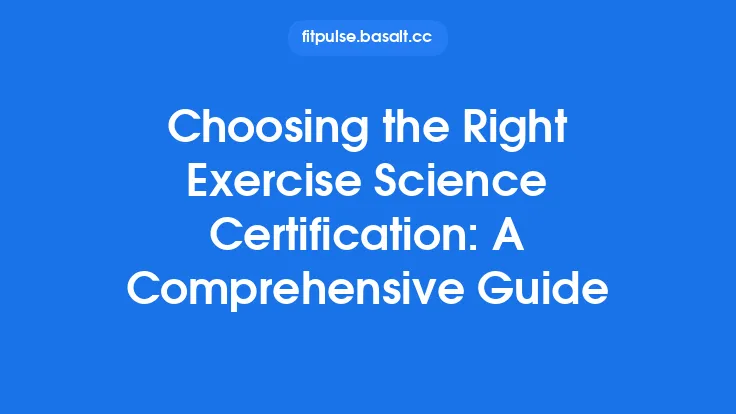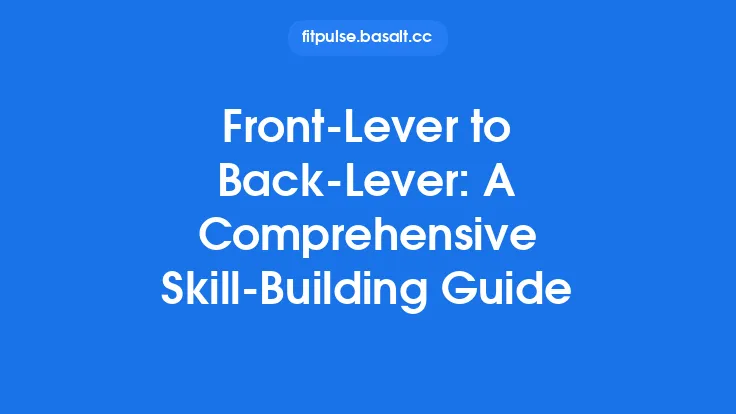Building a career after earning an exercise science credential is a journey that blends scientific knowledge, practical skill, personal branding, and strategic planning. While the credential itself opens doors, the long‑term success of a professional hinges on how well they translate that foundation into real‑world impact. Below is a comprehensive roadmap that walks you through the essential steps, decisions, and habits that will help you shape a rewarding and sustainable career in the exercise science field.
Understanding the Landscape of Exercise Science Careers
The exercise science arena is far broader than the traditional “personal trainer” label. Professionals with a solid academic background can find roles in:
| Sector | Typical Positions | Core Responsibilities |
|---|---|---|
| Clinical & Rehabilitation | Exercise Physiologist, Cardiac Rehab Specialist, Geriatric Exercise Specialist | Design and supervise therapeutic exercise programs for patients with chronic disease, injury, or age‑related limitations. |
| Performance & Sports | Strength & Conditioning Coach, Sports Performance Analyst, Athletic Trainer (with additional certification) | Optimize athletic performance, develop periodized training plans, and monitor injury prevention strategies. |
| Corporate Wellness | Wellness Coordinator, Employee Health Coach, Corporate Fitness Manager | Create and manage wellness initiatives that improve employee health, reduce absenteeism, and boost productivity. |
| Research & Academia | Laboratory Researcher, Faculty Member, Curriculum Developer | Conduct studies on human performance, publish findings, and teach the next generation of professionals. |
| Entrepreneurial & Private Practice | Owner of a boutique studio, Online Coaching Business, Mobile Fitness Service | Build a brand, market services, and manage all aspects of a client‑focused business. |
| Public Health & Community Programs | Community Fitness Director, Public Health Exercise Specialist | Develop community‑wide programs that address obesity, chronic disease prevention, and health equity. |
Understanding where you fit—or where you’d like to fit—helps you target the right opportunities and tailor your professional development accordingly.
Identifying Your Professional Interests and Strengths
- Self‑Assessment Tools – Use structured questionnaires (e.g., StrengthsFinder, Myers‑Briggs) to surface natural inclinations.
- Reflect on Academic Highlights – Which courses or research projects excited you most? Lab work, biomechanics, nutrition, or behavior change?
- Shadow Professionals – Spend a day with a clinical exercise physiologist, a sports performance coach, and a corporate wellness manager. Observe daily tasks, challenges, and required soft skills.
- Map Skills to Roles – Create a two‑column table: one for “hard skills” (e.g., VO₂ max testing, movement analysis) and one for “soft skills” (e.g., client communication, project management). Align each skill set with potential job titles.
A clear picture of your interests and strengths will guide the next steps—whether you aim for a research‑intensive path, a client‑facing role, or a hybrid position.
Crafting a Targeted Resume and Professional Profile
- Headline Over Objective – Replace generic objectives with a concise headline that states your credential and desired role (e.g., “Certified Exercise Physiologist Seeking Clinical Rehabilitation Position”).
- Quantify Achievements – Instead of “conducted fitness assessments,” write “performed over 200 VO₂ max tests, improving client baseline endurance by an average of 12% within 12 weeks.”
- Include Relevant Keywords – Many employers use applicant tracking systems (ATS). Incorporate terms such as “periodized training,” “evidence‑based programming,” “behavior change counseling,” and the specific certification you hold.
- Showcase Practical Experience – Highlight internships, practicum projects, volunteer work, and any freelance coaching. Even short‑term experiences demonstrate applied knowledge.
- Professional Online Presence – Maintain an up‑to‑date LinkedIn profile, a personal website, or a portfolio that includes case studies, client testimonials (with permission), and any published articles or conference presentations.
A polished, data‑driven resume paired with a strong digital footprint positions you as a serious candidate in a competitive market.
Leveraging Internships, Practicums, and Volunteer Work
- Treat Every Placement as a Mini‑Job – Arrive on time, ask for feedback, and document your contributions.
- Seek Diverse Settings – Rotate through a clinical lab, a sports team, and a community center if possible. This breadth demonstrates adaptability.
- Request Formal Evaluations – A supervisor’s written assessment can become a powerful reference or a bullet point on your résumé.
- Network Within the Placement – Connect with staff members on LinkedIn, attend department meetings, and ask to shadow senior professionals.
These experiences not only build competence but also generate contacts who may become future employers or mentors.
Building a Strong Professional Network
- Professional Associations – Even if you avoid deep dives into their accreditation role, joining groups such as the American College of Sports Medicine (ACSM) or the National Strength and Conditioning Association (NSCA) provides access to local events, job boards, and mentorship programs.
- Conferences and Workshops – Attend at least one national or regional conference per year. Participate in poster sessions, ask questions during panels, and exchange business cards.
- Online Communities – Engage in niche forums (e.g., Reddit’s r/exercisephysiology, specialized Facebook groups). Share insights, answer questions, and subtly showcase your expertise.
- Informational Interviews – Reach out to professionals whose career paths you admire. A 15‑minute conversation can reveal hidden opportunities and give you a personal advocate.
Networking is a two‑way street: give value first, and the relationships will often pay dividends later.
Choosing a Specialty or Niche
Specialization differentiates you in a crowded field. Consider the following pathways:
| Niche | Why It Might Appeal | Typical Additional Training |
|---|---|---|
| Metabolic Health | Growing demand for obesity and diabetes management | Courses in nutrition, behavior change, metabolic testing |
| Youth Sports Performance | Passion for working with athletes ages 8‑18 | Youth coaching certifications, child development coursework |
| Senior Fitness & Mobility | Aging population, high need for functional training | Geriatric exercise specialization, fall‑prevention workshops |
| Corporate Wellness Program Design | Interest in large‑scale health initiatives | Business management basics, HR collaboration training |
| Biomechanics & Motion Analysis | Love for data‑driven performance insights | Advanced coursework in kinesiology, certification in motion capture systems |
Select a niche that aligns with both market demand and personal enthusiasm. Once chosen, focus your continuing education, networking, and job search around that specialty.
Gaining Practical Experience Through Entry‑Level Roles
Even after earning a credential, many professionals start in positions that serve as stepping stones:
- Fitness Center Associate – Provides exposure to client interaction, program design, and facility operations.
- Rehabilitation Assistant – Works under a licensed therapist, learning clinical documentation and patient progression.
- Research Technician – Assists in data collection and analysis, sharpening scientific rigor.
- Wellness Intern for a Corporate Entity – Helps design health challenges, gaining insight into organizational dynamics.
Treat each role as a learning platform. Request additional responsibilities, such as leading a small group class or assisting with a research protocol, to broaden your skill set.
Advancing Through Continuing Skill Development
While you are not focusing on recertification specifics, staying competent requires ongoing learning:
- Micro‑Credentials – Short, stackable courses (e.g., “Advanced Plyometrics,” “Motivational Interviewing for Health Professionals”) can be added to your résumé quickly.
- Journal Club Participation – Join a local or online group that reviews recent peer‑reviewed articles. This habit keeps you abreast of evidence‑based practices.
- Software Proficiency – Master tools like Excel for data analysis, MyFitnessPal for nutrition tracking, or specialized platforms such as Dartfish for video analysis.
- Public Speaking – Volunteer to present at community health fairs or internal staff meetings. Communication skills are essential for leadership and client education.
A habit of regular, targeted skill upgrades signals to employers that you are proactive and future‑ready.
Pursuing Advanced Education and Certifications Strategically
If you decide that a master’s degree, doctoral program, or an additional certification will accelerate your goals, approach it strategically:
- Define the ROI – Estimate how the credential will affect salary, job eligibility, and career trajectory.
- Select Programs with Strong Industry Ties – Schools that host internships, have alumni in leadership positions, or partner with local health systems provide built‑in networking.
- Consider Part‑Time or Online Formats – This allows you to work while studying, preserving income and practical experience.
- Leverage Employer Tuition Assistance – Many health clubs, hospitals, and corporations offer educational reimbursement for relevant degrees.
Advanced education should be a purposeful investment, not a default step.
Transitioning to Leadership or Management Positions
Moving from practitioner to manager involves a shift in focus:
- Develop Business Acumen – Learn budgeting, staffing, and performance metrics. Short courses in health‑care management or an MBA concentration in sports management can be valuable.
- Mentor Junior Staff – Demonstrate leadership by coaching new hires, creating onboarding guides, or leading staff meetings.
- Showcase Program Outcomes – Compile data on client retention, injury reduction, or performance gains to illustrate your impact.
- Seek Formal Leadership Roles – Apply for titles such as “Program Director,” “Head Coach,” or “Wellness Manager” when you have a track record of measurable results.
Leadership positions often come with higher compensation and broader influence over organizational culture.
Starting Your Own Business or Private Practice
Entrepreneurship is a viable path for many exercise science professionals:
- Validate the Market – Conduct a local needs assessment. Identify gaps (e.g., lack of post‑rehab services, limited youth strength programs).
- Create a Business Plan – Outline services, pricing, target demographics, marketing strategy, and financial projections.
- Legal and Insurance Considerations – Register your business entity, obtain liability insurance, and ensure compliance with local health regulations.
- Build a Brand – Develop a professional logo, website, and social media presence. Consistent branding builds trust.
- Client Acquisition – Use referral programs, community workshops, and partnerships with physicians or schools to generate leads.
- Systems and Technology – Implement scheduling software, electronic health records (if clinical), and payment processing tools to streamline operations.
Running your own practice allows you to shape service delivery, set your schedule, and directly reap the financial rewards of your expertise.
Navigational Tips for Salary Negotiation and Benefits
- Research Benchmarks – Use resources like the Bureau of Labor Statistics, industry salary surveys, and Glassdoor to understand typical compensation for your role and region.
- Quantify Your Value – Present data on client outcomes, program growth, or cost savings you have delivered. Numbers strengthen your negotiating position.
- Consider Total Compensation – Benefits such as health insurance, retirement matching, continuing education stipends, and paid time off can be as valuable as base salary.
- Practice the Conversation – Role‑play with a mentor or friend. Prepare concise talking points and be ready to discuss both salary and non‑salary perks.
Effective negotiation sets the foundation for long‑term financial satisfaction.
Maintaining Work‑Life Balance and Preventing Burnout
A career centered on health can paradoxically lead to personal neglect if boundaries are not set:
- Schedule Personal Recovery – Treat your own rest days, nutrition planning, and mental‑health activities with the same rigor as client appointments.
- Set Session Limits – Avoid back‑to‑back client sessions without breaks; incorporate short movement or breathing exercises between appointments.
- Delegate Administrative Tasks – Use virtual assistants or software automation for billing, client follow‑ups, and social media posting.
- Professional Support – Join peer‑support groups or seek supervision when dealing with challenging client cases or high stress.
Sustaining your own well‑being ensures you can consistently deliver high‑quality service to others.
Staying Current with Industry Research and Best Practices
Even after establishing a career, continuous learning remains essential:
- Subscribe to Core Journals – Journal of Applied Physiology, Medicine & Science in Sports & Exercise, and International Journal of Sports Physiology and Performance provide cutting‑edge research.
- Set a Weekly Reading Goal – Allocate 30–45 minutes each week to skim abstracts and read full articles relevant to your niche.
- Attend Local Seminars – Universities, hospitals, and professional societies often host free or low‑cost talks.
- Contribute to the Knowledge Base – Write blog posts, present at community events, or co‑author research papers. Teaching reinforces your own mastery and raises your professional profile.
A habit of lifelong learning keeps you adaptable and respected in a field that evolves with scientific discovery.
By systematically assessing your interests, building a compelling professional brand, gaining diverse experience, and strategically advancing your expertise, you can transform an exercise science credential into a thriving, fulfilling career. Whether you envision yourself as a clinical leader, a performance specialist, a corporate wellness architect, or an entrepreneur shaping the future of health, the roadmap above provides the evergreen principles and actionable steps needed to turn that vision into reality.





